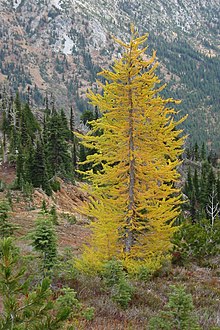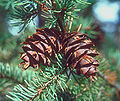
Pseudotsuga is a genus of evergreen coniferous trees in the family Pinaceae. Common names for species in the genus include Douglas fir, Douglas-fir, Douglas tree, Oregon pine and Bigcone spruce. Pseudotsuga menziesii is widespread in western North America and is an important source of timber. The number of species has long been debated, but two in western North America and two to four in eastern Asia are commonly acknowledged.
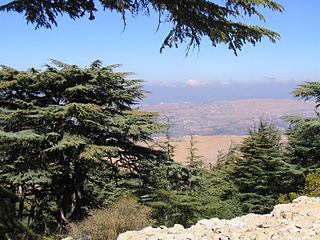
Cedrus, with the common English name cedar, is a genus of coniferous trees in the plant family Pinaceae. They are native to the mountains of the western Himalayas and the Mediterranean region, occurring at altitudes of 1,500–3,200 m in the Himalayas and 1,000–2,200 m in the Mediterranean.

Conifers are a group of cone-bearing seed plants, a subset of gymnosperms. Scientifically, they make up the division Pinophyta, also known as Coniferophyta or Coniferae. The division contains a single extant class, Pinopsida. All extant conifers are perennial woody plants with secondary growth. The great majority are trees, though a few are shrubs. Examples include cedars, Douglas-firs, cypresses, firs, junipers, kauri, larches, pines, hemlocks, redwoods, spruces, and yews. The division Pinophyta contains seven families, 60 to 65 genera, and more than 600 living species.

The order Pinales in the division Pinophyta, class Pinopsida, comprises all the extant conifers. The distinguishing characteristic is the reproductive structure known as a cone produced by all Pinales. All of the extant conifers, such as Araucaria, cedar, celery-pine, cypress, fir, juniper, kauri, larch, pine, redwood, spruce, and yew, are included here. Some fossil conifers, however, belong to other distinct orders within the division Pinophyta.

Larches are deciduous conifers in the genus Larix, of the family Pinaceae. Growing from 20 to 45 metres tall, they are native to the cooler regions of the northern hemisphere, where they are found in lowland forests in the high latitudes, and high in mountains further south. Larches are among the dominant plants in the boreal forests of Siberia and Canada. Although they are conifers, larches are deciduous trees that lose their needles in the autumn.

The gymnosperms are a group of seed-producing plants that includes conifers, cycads, Ginkgo, and gnetophytes, forming the clade Gymnospermae. The term gymnosperm comes from the composite word in Greek: γυμνόσπερμος, literally meaning 'naked seeds'. The name is based on the unenclosed condition of their seeds. The non-encased condition of their seeds contrasts with the seeds and ovules of flowering plants (angiosperms), which are enclosed within an ovary. Gymnosperm seeds develop either on the surface of scales or leaves, which are often modified to form cones, or on their own as in yew, Torreya, Ginkgo. Gymnosperm lifecycles involve alternation of generations. They have a dominant diploid sporophyte phase and a reduced haploid gametophyte phase which is dependent on the sporophytic phase. The term "gymnosperm" is often used in paleobotany to refer to all non-angiosperm seed plants. In that case, to specify the modern monophyletic group of gymnosperms, the term Acrogymnospermae is sometimes used.

The Pinaceae, or pine family, are conifer trees or shrubs, including many of the well-known conifers of commercial importance such as cedars, firs, hemlocks, piñons, larches, pines and spruces. The family is included in the order Pinales, formerly known as Coniferales. Pinaceae are supported as monophyletic by their protein-type sieve cell plastids, pattern of proembryogeny, and lack of bioflavonoids. They are the largest extant conifer family in species diversity, with between 220 and 250 species in 11 genera, and the second-largest in geographical range, found in most of the Northern Hemisphere, with the majority of the species in temperate climates, but ranging from subarctic to tropical. The family often forms the dominant component of boreal, coastal, and montane forests. One species, Pinus merkusii, grows just south of the equator in Southeast Asia. Major centres of diversity are found in the mountains of southwest China, Mexico, central Japan, and California.

Tsuga is a genus of conifers in the subfamily Abietoideae of Pinaceae, the pine family. The common name hemlock is derived from a perceived similarity in the smell of its crushed foliage to that of the unrelated plant poison hemlock. Unlike the latter, Tsuga species are not poisonous.

Cathaya is a genus in the pine family, Pinaceae, with one known living species, Cathaya argyrophylla. Cathaya is a member of the subfamily Laricoideae, most closely related to Pseudotsuga and Larix. A second species, C. nanchuanensis, is now treated as a synonym, as it does not differ from C. argyrophylla in any characters.

Cedrus deodara, the deodar cedar, Himalayan cedar, or deodar, is a species of cedar native to the Himalayas.

Pseudolarix amabilis is a species of coniferous tree in the pine family Pinaceae. The species is commonly known as golden larch, but being more closely related to Keteleeria, Abies and Cedrus, is not a true larch (Larix). P. amabilis is native to eastern China, occurring in small areas in the mountains of southern Anhui, Zhejiang, Fujian, Jiangxi, Hunan, Hubei and eastern Sichuan, at altitudes of 100–1,500 m (328–4,921 ft). The earliest known occurrences are of compression fossils found in the Ypresian Allenby Formation and mummified fossils found in the Late Eocene Buchanan Lake Formation on Axel Heiberg Island.
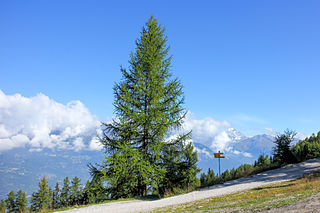
Larix decidua, the European larch, is a species of larch native to the mountains of central Europe, in the Alps and Carpathian Mountains as well as the Pyrenees, with disjunct lowland populations in northern Poland and southern Lithuania. It is widely naturalized in Scandinavia. Its life span has been confirmed to be close to 1000 years but is more often around 200 years. It is claimed that one of the larches planted by the second Duke of Atholl at Dunkeld in 1738 is still standing.

Nothotsuga is a genus of coniferous trees in the family Pinaceae endemic to China. Nothotsuga contains only one species, Nothotsuga longibracteata, commonly known as the bristlecone hemlock, which is found in southeastern China, in southern Fujian, northern Guangdong, northeast Guangxi, northeast Guizhou, and southwest Hunan.

Keteleeria is a genus of three species of coniferous trees in the family Pinaceae first described as a genus in 1866.

Pseudolarix is a genus of coniferous trees in the pine family Pinaceae containing three species, the extant Pseudolarix amabilis and the extinct species Pseudolarix japonica and Pseudolarix wehrii. Pseudolarix species are commonly known as golden larch, but are not true larches (Larix) being more closely related to Keteleeria, Abies and Cedrus. P. amabilis is native to eastern China, occurring in small areas in the mountains of southern Anhui, Zhejiang, Fujian, Jiangxi, Hunan, Hubei and eastern Sichuan, at altitudes of 100–1,500 m (328–4,921 ft). P. wehrii is described from fossils dating to the Early Eocene (Ypresian), of Western North America where it is found in the Eocene Okanagan Highlands Allenby and Klondike Mountain Formations. The youngest known occurrence is of mummified fossils found in the Late Eocene Buchanan Lake Formation on Axel Heiberg Island. P. japonica is known from Middle Miocene to Pliocene sediments in Japan and Miocene deposits of Korea. Fossils assigned to Pseudolarix as a genus date possibly as old as the Early Cretaceous Hauterivian stage in Mongolia.

Larix kaempferi, the Japanese larch or karamatsu in Japanese, is a species of larch native to Japan, in the mountains of Chūbu and Kantō regions in central Honshū.

Abietoideae is a subfamily of the conifer family Pinaceae. The name is from the genus Abies (firs), which contains most of the species in the genus. Six genera are currently assigned to this subfamily: Abies, Cedrus, Keteleeria, Nothotsuga, Pseudolarix, and Tsuga.

Larix griffithii, the Sikkim larch, is a species of larch, native to the eastern Himalaya in eastern Nepal, Sikkim, western Bhutan and southwestern China, growing at 1,800–4,100 metres (5,900–13,500 ft) in altitude.
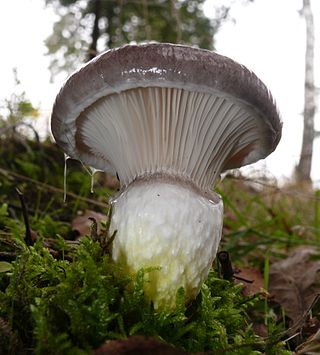
Gomphidius is a genus of mushrooms, commonly known as spike-caps, that are members of the Boletales, or pored fungi. They appear to have gill-like structures which resemble those of agarics, however the similarity is superficial only. The best-known member is the slimy spike-cap. The genus has a widespread distribution, especially in north temperate areas, and contains 10 species.
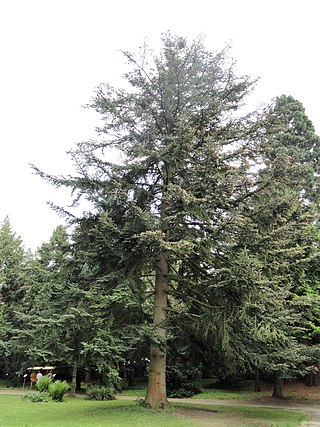
Abies chensiensis, the Shensi fir, is a fir native to Gansu, Hubei, Sichuan, Tibet, Yunnan in China, and Arunachal Pradesh in India. It was first described by Philippe Édouard Léon Van Tieghem in 1892.
